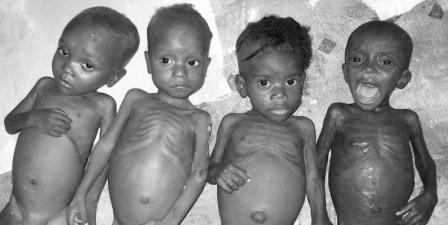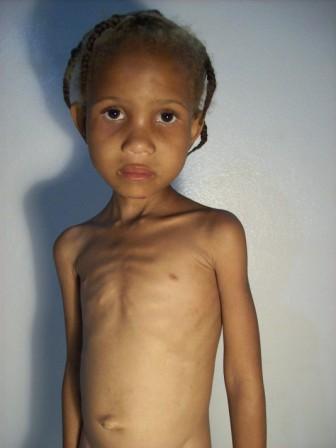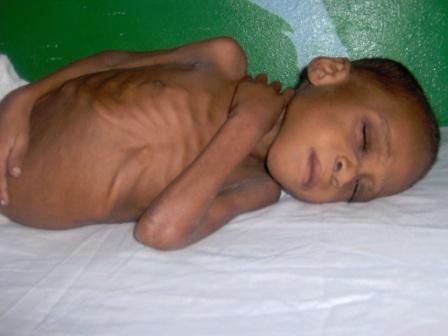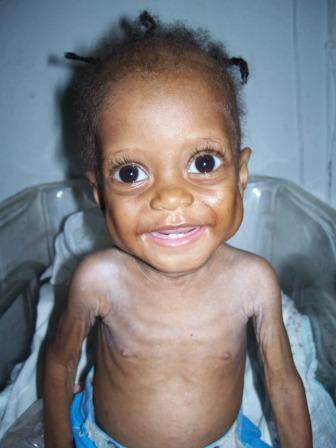Graham Sowa is a good friend of Real Hope for Haiti. He is currently in medical school in Cuba and wrote the below paper. We will be sharing it in several different post. It is a good read to help understand the effects of what kwashiorkor and malnutrtion does to the body.
This paper has been divided into three parts.
First, I will review concepts of malnutrition and undernutrition, and their respective effects on the nervous system´s development and function.
Second, I will review various methods used to treat childhood malnutrition.
Third is an examination of ready to use therapeutic food (RUTF) in treating infants and children at the Real Hope for Haiti Rescue Center.
I. Introduction
In 1963, Professor P. M. Smythe, at the University of Natal in South Africa, posed a question as the title to his research paper: “Does undernutrition during infancy inhibit brain growth and subsequent intellectual development”? (Smyth & Stoch, 1963) After 13 years of longitudinal study of two groups of children (undernourished vs. control), he concluded that undernourishment leads to “organic brain dysfunction, dominantly on the central neurointegrative level”. (Smythe & Stoch, 1976)
Almost all studies since then have relied on similar methods and measurement tools used by Professor Smythe. Such studies frequently compare a nourished group and undernourished group (one functioning as the control group, the other as the variable group). Body growth measurements (biometrics), such as weight, height, and head and mid-upper arm circumference are often compared between the groups. Psychological development tests have also been used, even though they are often complicated by multiple variables (social, cultural and economic considerations) that exist outside the scope of these studies. Forms of electronic imaging, such as electroencephalograms (EEGs), X-rays of the skull and brain, and more recently, computerized axial tomography (CAT) and magnetic resonance imaging (MRI) are used to measure brain activity and development.
Our brains, and corresponding head circumference, grow more during the first two years of our life than all of the years that follow, combined. A newborn that achieved a full nine months gestation with a birth weight of 3 kg usually has a head circumference of 34 cm. By the second year of life, the head circumference is 47-48 cm. In the first two years after birth the head circumference increases by 13-14 cm. In the next 13 years of growth (by the 15th birthday), the head circumference will only increase by an additional 5-7 cm. (Navarro & González, 2007)[i] This growth, of the bones of the skull and the brain inside, are variables of receiving proper nutrients during those first two years of life.
I. nutritional failure and the nervous system
Without nutrients to convert into energy or to build structures, our bodies die. The human brain uses more energy, much more energy, than other individual organ systems. Even though the brain makes up about 2% of the weight of our body, it accounts for at least 15% of our metabolic activity. (Guyton & Hall, 1998) The source of energy in this metabolic activity of the brain mostly comes from sugars, also called carbohydrates. In fact, at rest, the brain consumes more than 50% of the carbohydrates we eat, mostly in the form of a sugar called glucose. (Bourre, 2006) We are literally burning calories just thinking about things.
As interesting as it would be to conceptualize a weight loss program that only involved the exercise of the mind that is not the goal of this paper. Instead we are going to explore the inverse: When there are no calories to burn for energy, or nutrients to build new structures, we are unable to think about things. Our cognitive, sensorial, and motor functions suffer as a result. Like the rest of the body, the nervous system needs nutrients to build and maintain its structure and function, its morpho-physiological homeostasis.
The first years of life are the most critical for successful development of an individual’s full mental capacities. It should be noted that prenatal nutrition of the mother is equally, if not more important, than nutrition after birth. (Kehoe, Mallinson, Bronzino, & McCormick, 2001) However, this is outside of the scope of this investigation.
critical macronutrients needed in the nervous system
In humans, the critical period for development of the central nervous system extends from the second trimester of pregnancy to the child’s second birthday. We saw this above with the rapid growth of the skull. During this period, most of the neurons and their associated cells, the microglia, are manufactured by the body. Microglia is responsible for the rapid growth of the brain in this period. During its growth, and especially during its function, the brain is in need of energy, as was explained above.
Here we will briefly review the macromolecules, which are delivered to the body through the food we eat, needed for the replication of neurons, their associated support cells (the microglia), and sources of energy needed for the brain to function as an organ. The macromolecules that we will examine are essential fatty acids, proteins, and carbohydrates.
fatty acids
At least two fatty acids, both types of omega fatty acids, have been identified as necessary components for life and the neural function of the brain: linoleic acid (LA) and alpha-linoleic acid (ALA) or vitamin F. (Bourre, 2006) Unlike body fat (adipose) and other body tissues, the brain does not use fat as a direct reserve source for energy. Instead, the fats in our brains participate in cerebral architecture, lipid signaling, and the regulation of the expression of our genetic material.
Because the first two years of life are a period of rapid brain growth, infants require five times as much fat, specifically omega-3 and omega-6 fatty acids, than adults. Breast milk from a healthy mother contains almost twice as much omega-3 fatty acid as most infant formulas. (Cunnane, Francescutti, Brenna, & Crawford, 2000) Fatty acids are crucial in neural development and any alternative source of nourishment to breast milk must include these macromolecules. Daily nutritional values of fatty acids are contained in fish, rapeseed and soybean oils, and walnuts. (Bourre, 2005)
- proteins and amino acids
The function, or physiology, of the brain requires at least eight essential amino acids, without which life would be impossible. (Bourre, 2006) We must ingest them to maintain homeostasis, or a balance of functions in the body.
When we consume protein, our bodies break down these large molecules into their smaller amino acid components. Amino acids then arrive to the central nervous system by using transporters to cross the blood brain barrier. Glutamine (a key component of the neurotransmitter glutamate) as well as carnitine, glutathione, tryptophan (a precursor to serotonin) and tyrosine are some of the amino acids that enter the central nervous system via transporters.
Amino acids are necessary to regulate bodily functions, through enzymes, and complete numerous required tasks for life. In the brain, amino acids form the structural elements of neural tissue and neurotransmitters (chemical messengers) to complete the activity of neural messaging.
Dopamine has been proposed as a key neurotransmitter in the formation of memories, without which our cognition is deeply interrupted. (Previc, 1999) A dopamine deficiency in the hippocampus (a part of the limbic system responsible for our emotions, motivations, and memories), can lead to failures in social development, as well as defects in our body’s ability to maintain homeostasis. More specifically, the hippocampus plays a key role in the “reward and punishment” part of our memory, where we associate our actions with their results. In other words, we can’t learn if we don’t feed our hippocampus.
Proteins also play a functional role in our ability to form long term memories, the process of storing memories for years and decades. Proteins literally make memories by making structural changes to presynaptic neurons. (Guyton & Hall, 1998)
Severe protein undernutrition in the first year of life decreases the rate of neuron proliferation and growth (along with the associated neuroglia). Because neuron proliferation is most active during the first two years of life, this severe protein malnutrition can result in permanent structural and physiological damage from an inadequate number of neurons and their support cells. (Noback, 2005)
Even in childhood kwashiorkor, after most neurons have formed, protein malnutrition still has severe effects. Connections between neural cells, and thus the body’s ability to transmit and store information, can be impaired. Childhood and adolescent kwashiorkor are most likely to interrupt the function of the hypothalamus and hippocampus. (Bourre, 2006) Also, the different and specialized roles of some cortical cells in the gray matter (or cortex) of the brain, might not be realized. The cortex is an area of the brain where sensorial and motor inputs and outputs are associated. The failure of this association has impacts on our personality, social behavior, and ability to communicate and plan for the future. (Guyton & Hall, 1998) (Noback, 2005)
glucose and carbohydrates
In the beginning of this paper, I stated that the human brain consumes at least 15% of available glucose. This is in a healthy adult. Infants’ brains consume up to 60% of the glucose available in the body. Once again, this highlights the vital time of brain development during infancy. (Chugani, 1998) To realize the full energy potential of glucose in our bodies, it must be consumed in the presence of oxygen; therefore a healthy circulatory system is a prerequisite for nutritional health. Also, to avoid daily periods of decreased glucose (hypoglycemia), glucose should be consumed as a starch (or complex carbohydrate), which leads to a slower and more regular distribution of energy in the body. (Bourre, 2006)
The human body does store carbohydrates to use in case of a decrease in glucose in our diet. Glucose storage (and synthesis) takes place in the liver. However, this reserve is finite and must be replenished with ingestion of various forms of carbohydrates. The prefrontal cortex, or the most anterior and superficial part of our brains, is especially susceptible to glucose shortages. Multiple studies have shown a correlation between hypoglycemic states and decreased functional activation of the prefrontal cortex. (Donohoe & Benton, 1999) (McNay, Fries, & Gold, 2000) However, unlike the possible permanent effects of infant undernutrition, hypoglycemia and its effects can be reversed with addition of starches and other complex carbohydrate to the diet. (Evans, Pernet, Lomas, & Jones, 2000)
Glucose levels have also been related to short term memory, a key part of our cognitive system for accomplishing tasks throughout the day and making plans. (Messier, Pierre, Desrochers, & Gravel, 1998)
We will continue with parts II and III in the coming weeks. Thanks Graham for being willing to share your research with us…much love from your island neighbors at RHFH.















Comments(3)
Karen says
September 22, 2011 at 11:06 amThank you for sharing this. Having a daughter that was likely malnourished during her first 5 years of life, this information is SO important to me.
I don’t know if I have ever commented on here before, but I read daily and pray for you all daily. The work you do in Haiti is truly the work of the Lord.
Holly says
September 22, 2011 at 8:12 pmGreat, really informative post! Thank you!